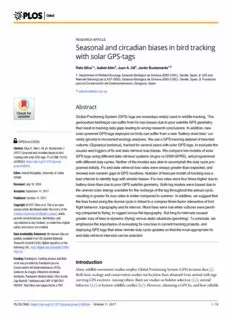
Seasonal and circadian biases in bird tracking with solar GPS-tags PDF
Preview Seasonal and circadian biases in bird tracking with solar GPS-tags
RESEARCHARTICLE Seasonal and circadian biases in bird tracking with solar GPS-tags RafaSilva1*,IsabelAfa´n2,JuanA.Gil3,JavierBustamante1,2 1 DepartmentofWetlandEcology,Estacio´nBiolo´gicadeDoñana(EBD-CSIC),Seville,Spain,2 GISand RemoteSensingLab(LAST-EBD),Estacio´nBiolo´gicadeDoñana(EBD-CSIC),Seville,Spain,3 Fundacio´n paralaConservacio´ndelQuebrantahuesos,Zaragoza,Spain *[email protected] a1111111111 a1111111111 Abstract a1111111111 a1111111111 GlobalPositioningSystem(GPS)tagsarenowadayswidelyusedinwildlifetracking.This a1111111111 geolocationtechniquecansufferfromfixlossbiasesduetopoorsatelliteGPSgeometry, thatresultintrackingdatagapsleadingtowrongresearchconclusions.Inaddition,new solar-poweredGPStagsdeployedonbirdscansufferfromanew“batterydrainbias”cur- rentlyignoredinmovementecologyanalyses.WeuseaGPStrackingdatasetofbearded OPENACCESS vultures(Gypaetusbarbatus),trackedforseveralyearswithsolarGPStags,toevaluatethe Citation:SilvaR,Afa´nI,GilJA,BustamanteJ causesandtriggersoffixanddataretrievallossbiases.Wecomparetwomodelsofsolar (2017)Seasonalandcircadianbiasesinbird GPStagsusingdifferentdataretrievalsystems(ArgosvsGSM-GPRS),andprogrammed trackingwithsolarGPS-tags.PLoSONE12(10): e0185344.https://doi.org/10.1371/journal. withdifferentdutycycles.Neitherofthemodelswasabletoaccomplishthedutycyclepro- pone.0185344 gramedinitially.Fixanddataretrievallossrateswerealwaysgreaterthanexpected,and Editor:AntoniMargalida,UniversityofLleida, showednon-randomgapsinGPSlocations.Numberoffixespermonthoftrackingwasa SPAIN badcriteriontoidentifytagswithsmallerbiases.Fix-lossrateswerefourtimeshigherdueto Received:July18,2016 batterydrainthanduetopoorGPSsatellitegeometry.Bothtagmodelswerebiaseddueto theunevensolarenergyavailablefortherechargeofthetagthroughouttheannualcycle, Accepted:September11,2017 resultingingreaterfix-lossratesinwintercomparedtosummer.Inaddition,wesuggestthat Published:October11,2017 thebiasfoundalongthediurnalcycleislinkedtoacomplexthree-factorinteractionofbird Copyright:©2017Silvaetal.Thisisanopen flightbehavior,topographyandfixinterval.Morefixeswerelostwhenvultureswereperch- accessarticledistributedunderthetermsofthe ingcomparedtoflying,inruggedversusflattopography.Butlongfix-intervalscaused CreativeCommonsAttributionLicense,which permitsunrestricteduse,distribution,and greaterlossoffixesindynamic(flying)versusstaticsituations(perching).Toconclude,we reproductioninanymedium,providedtheoriginal emphasizetheimportanceofevaluatingfix-lossbiasincurrenttrackingprojects,and authorandsourcearecredited. deployingGPStagsthatallowremotedutycycleupdatessothatthemostappropriatefix DataAvailabilityStatement:Allrelevantdataare anddataretrievalintervalscanbeselected. publiclyavailablefromtheSpanishNational ResearchCouncil(CSIC)digitalrepositoryatthe followingURL:http://digital.csic.es/handle/10261/ 155119. Funding:Fundingfortrackingdevicesandfield Introduction workwasprovidedbyFundacio´nparala Conservacio´ndelQuebrantahuesos(FCQ), ManywildlifemovementstudiesemployGlobalPositioningSystem(GPS)locationdata[1]. GobiernodeArago´n,MinisteriodeMedio Bothbasicecologyandconservationstudiesuselocationfixesobtainedfromanimalwithtags Ambiente,Fundacio´nBiodiversidad,ObraSocial carryingGPSreceivers.Amongothers,therearestudiesonhabitat-selection[2,3],animal CajaMadrid,Telefo´nicaandLIFE12NAT/ES/ 000322.RafaSilvawassupportedbyaPhD behavior[4,5]orhuman-wildlifeconflict[6,7].However,obtainingaGPSfix,andhowreliable PLOSONE|https://doi.org/10.1371/journal.pone.0185344 October11,2017 1/19 BiasesinsolarGPS-tags contractfromtheMinisteriodeEducacio´n,Cultura thislocationis,dependsonmanyfactorsthatarenotalwaystakenintoaccountinthesestud- yDeporte(FPU13-03484).Thefundershadnorole ies.NewGPS-trackingtagstendtogivethousandsoflocationswithveryhighspatialaccuracy. instudydesign,datacollectionandanalysis, Theycangivethefalseimpressionofanunbiasedaccountofthebehaviorandwhereaboutsof decisiontopublish,orpreparationofthe theanimalswhichcarrythem.But,iffixesarenotobtainedatrandom,morefixesarenotnec- manuscript. essarilybetter.Thiscanbespeciallytrickyifanimalbehaviororhabitatusehasaninfluenceon Competinginterests:Theauthorshavedeclared theprobabilityoflosingafix. thatnocompetinginterestsexist. Onepotentialtrackingbiasisduetothelossoffixesifthereceiveronthetagfailstoreceive signalsfromaminimumofthreesatellitesduringthelimitedtimetheGPSreceiverison,and thus,cannotcalculateafix.Thisfact,thatnotallscheduledlocationsareobtained,hassome- timesbeencalledintheliteratureas“fix-ratebias”[8].Inthisworkwewillusetheterm“fix- lossrate”(FLR)todescribetherateatwhichscheduledlocationsarenotobtained,calculated astheinverseoffixsuccessrate,andusethe“fixratebias”torefertoanybiasinthefixingrate causedbyenvironmental,technical,orbehavioralfactors.Theexistenceofbiasinthefixes thatareroutinelylossisanimportanteffectthathastobeconsideredintheanalysisofanimal movement,andsolutionshavetobedesignedtomitigatethem[9]. ManystudiesthathavegainedaninsightintoFLRbiashavebeenbasedonbatteryoperated GPS-tagsdeployedonterrestrialmammals[8,10–12].TheyhaveconcludedthatFLRbiasis influencedmainlybyGPSsatellitegeometry,fixinterval(intervalbetweensuccessivefixes), habitatuse,animalbehavior,orevenGPS-tagpositionandorientation.Itiswellknownthatas theamountofvisibleskyfortheGPSreceiverdecreases(creatingwhatisknownasapoor GeometricDilutionofPrecision,orpoor-GDOP)theriskoflosingthefixincreases[13]. Thus,environmentalfactorsthatpreventaclearviewofthesky,suchasruggedtopographyor canopyclosure,havebeendocumentedashavinganinfluenceonFLR[14,15].Somestudies haveshownthatasmallerfixintervalsyieldsasmallerFLR[14,16,17].Ithasalsobeendemon- stratedthatinactiveanimalshavehigherFLRthanactiveones[18]. Althoughthesestudieshaveresolvedmostoftheissuesinfixratebiasinbattery-operated trackingdevicesusedmainlyinterrestrialmammals,biasinsolar-poweredtagsfrequently usedforbirdtrackingremainsvirtuallyunexplored.Solardeviceswithrechargeablebatteries areessentialtotrackbirds,whichrequirelightlong-lastingtags.Birdsalsomoveinathree dimensionalspaceandtagretrievalisdifficult.Therefore,remotedataretrievalsystemsare alsoneeded,requiringextrabatteryfordatadownloadcomparedtodeviceswhichlogthedata andarelatterrecovered.Asaresult,onlydevicesusingsolarrechargeablebatteriesseemable toofferanadequatesolutiontothisproblem.Torechargethebatterysolartagsrequiresolar radiation,whichvariesextremelyovertheyear,isaffectedbyweather,andcanbeinfluenced bydeviceattachment(e.g.becoveredbyfeathers),andbirdbehavior.Researchersareusually keentogetasmuchdataaspossiblebutintensiveschedulescancompromisetheenergyavail- ablefortagoperationandcreatedatagaps.Todate,wehaveonlyfoundtwostudiesmention- ingthenegativeinfluenceofbatterydrainonFLR[17,19].Insummary,althoughthetrendin tagdevelopmenthasleadtowardsanewgenerationoflightertrackingdeviceswithmoreeffi- cientpowersolutions,technologyhasnotadvancedenoughyetsothattheriskoflosingfixes orlosingdataretrievalattemptsinanon-randomwayduetoaninsufficientbatteryperfor- mancecanbesafelyignored. Lowbatterycapacityandperformance,andpoorGDOParenotgenerallydirectcausesof poorGPS-tagperformancebuttheresultingeffectsofacombinationofotherfactorsrelatedto theelectronics,firmware,andqualityofthecomponents.Forexample,thesuboptimalperfor- manceoftheunitscanbeaconsequenceofnonoptimalarrangementoftheelectronics. Antennadesignisoftenconstrainedbythesizeoftheunitsandmightnotbeoptimalcausing lowantennasensitivityandthisincreasesthetimeneededforsearchingsatellitesandacquiring ephemerides(increasingbatterydrain).Alowantennasensitivityalsoreducesthenumberof PLOSONE|https://doi.org/10.1371/journal.pone.0185344 October11,2017 2/19 BiasesinsolarGPS-tags satellitesreceived(thusaffectingDOP).Batterychargeisalsodeterminedbytheefficiencyof thecircuitrycontrollingthesolarrecharging,anddevicesfromdifferentcompaniescanuse differentcomponentsfortheircircuitry.Alltheseaspectscreatedifferencesbetweentagmod- elsthatcanbeevaluatedinthelab,buttheeffectofbirdbehaviororhabitatselectionontag efficiencycanonlybeevaluatedwithrealdeploymentsonbirds. Besidesfixinterval,thedataretrievalinterval(intervalbetweensuccessivedataretrievals)is anotherparameterwhichisusuallyscheduledinthetagdutycycle.Mosttagscanstoreon boardtheGPSlocationsandonlydeletethemoncesuccessfullytransmitted.Dependingon thestudyobjectives,dataretrievalintervalcanbecriticaltoachievesuccessinthetrackingpro- gram.Speciesconservationandmanagementprogramsusuallyrequestaquasi-real-time trackingtopreventorquicklyidentifypotentialmortalityeventsduetopoisoning,accidents withpowerlinesorillegalhunting[20–22],mainlyatcriticallife-stagessuchasjuveniledis- persalorduringbreeding[23].Thismeansmanagerswouldaskforfrequentdataretrievals, every1–2daysintheworstscenario.Argos(www.argos-system.com)PlatformsTransmitters Terminals(PTTs)hasbeentheonlysystemavailableforanimaltrackingsincethe1970sfor studiesrequiringworldwidecoverageandinthemid1990sthesystemintegratedGPSreceiv- ersonthePTTs[24]toobtainhigh-spatial-resolutiontrackingdata.Inthelastdecade,some GPStagsdeployedonanimalshavestartedtousemobilenetworkdataservicesfordata retrieval[25].GSM/SMS(GlobalSystemforMobilecommunications/ShortMessageService) andthemorerecentGSM/GPRS(GeneralPacketRadioServiceforlargerdatasets)have emergedascheaperalternativestotheArgossystem.Unfortunately,therearestillextensive areasthroughouttheworld(e.g.areasinAmerica,NorthAsia,Australia,Africa,andpracti- callyalloceans)withoutGSMservices[26].Inthesameway,dataretrievalsystemsusingradio modemtechnologyasVHF/UHFornewprotocolslikeZigbeeorBluetoothareasolidalterna- tive.Theyaresecure,robust,andcheapersystems,andtheyrequirelesspower[27–29]allow- inghigherdatatransferratesthanArgosorGSM.Howevertheyareonlyappropriatefor short-rangedownloads,andhence,inadequateforspecieswithunpredictablemovements. InthispaperouraimistoevaluatetheexistenceofFLRbiasinsolar-poweredGPS-tagsand determineitscausesusingdatafromtwotagmodelsdeployedonbeardedvultures(Gypaetus barbatus).Beardedvulturesareparticularlyadequateforthistest.Theyinhabitmountain rangeswitharuggedtopographythatcreatesdifficultiesforGPSlocation.Thestronglyvari- ableweatherconditions,andtheseasonalvariationinsolarradiationmakesdifficulttopredict theperformanceofsolar-poweredGPStagsthatarefrequentlyusedinconservationprojects. Beardedvulturesrequireslopewindsandthermalupdraftstofly,creatingacircadianpattern inflightbehaviorthatcouldinfluencethevisibilityofGPSsatellitesforthetags.Weattemptto findoutwhyGPStagsdeployedonbeardedvultureslosefixesandifthistakesplacewitha non-randompattern.WeevaluateFLRandtrytoattributeitto"batterydrain"(thetaghasnot enoughenergytoattemptafix)ortopoorGPSsatellitegeometry(thetagisnotabletocontact withenoughsatellites,poor-GDOPhereafter).Weevaluatetheinfluenceofotherinteracting factorssuchasseasonalvariationinsolarradiation,fixinterval,topography,andbirdflight behavior.OurfirsthypothesisisthatFLRinsolartagsdeployedonbeardedvulturesisnon- random,neitheralongtheyear,norduringthedailycycle,andisstronglydependentonthe energyavailabilityforthetag.Accordingly,weexpectthathighcloudcoverageandshorter daysinwinterwouldproducehigherFLR,becausesolartagsdonotfullyrecharge,andcreate aseasonalbiasinnumberoffixesacquired.OursecondhypothesisisthatFLRisalsostrongly influencedbyhabitatuseandbirdbehavior.Differencesintheintensityofflightbehavior alongthediurnalcycleexposethetagstodifferentrelativesatellite-receivergeometries (GDOP),andpotentiallyalsotodifferentbatteryrechargeopportunities.Inthisworkwealso assesstheperformanceoftwodifferentdataretrievalsystemsthathavebeenused(Argosand PLOSONE|https://doi.org/10.1371/journal.pone.0185344 October11,2017 3/19 BiasesinsolarGPS-tags GSM/GPRS).Relatedtoourfirsthypothesis,thelossofdataretrievals,dataretrievallossrate (hereafterDRLR),shouldfollowthesamepatternasFLRthroughouttheyear,astheenergy consumptionfordatatransmissionisevengreaterthanforfixcollection. Materialsandmethods Ethicsstatements Thisstudywasconductedasapartofalong-termconservationandresearchprogramleaded bytheFundacio´nparalaConservacio´ndelQuebrantahuesos(www.quebrantahuesos.org)in accordancewiththecompetentauthoritiesinthemanagementofthisspecieslistedasendan- gered(EN)intheNationalCatalogueofThreatenedSpeciesofSpain(R.D.139/2011,BOE n.46,23thFebruary2011),aswellasinAnnexeIoftheEuropeanBirdsDirective(Directive 2009/147/EC)andSPEC-3category(Europeanthreatenedspecies).Alltheprocedureshave beenspecificallycarriedoutwithauthorizationoftheNatureConservationAuthorityofthe GovernmentofAragon,incompliancewiththeregionalDecree45/2003(BOAn.29,25thFeb- ruary2003)andfollowingtheprotocolsestablishedbytheStrategyforConservationofthe BeardedVultureinSpain(NationalCommissionforProtectionofNature,4thJune2000). Speciesandstudyarea Thebeardedvultureisaspecializedandterritorialscavengerfeedingmainlyonbonesand inhabitingruggedmountainousareas,inwhichtakesadvantageofslopesoaringinorderto exploitwithlowenergycoststhelargeareasthatmakeuptheirterritories.Nestsareusually locatedonremoteoverhungcliffledgesorincaves.Itisanendangeredspeciesremainingina fewmountainrangesinEurope,Asia,andAfrica[30].InEurope,thelargestbreedingnatural populationisinthePyrenees(170breedingpairs),withothersmallerpopulationsinCreteand Corsica.TherehavebeensuccessfulreintroductionprojectsintheAlpsandAndalusianmoun- tains,wherethespecieswaseradicated.Thespeciesmovementshavebeenstudiedsincethe 1980’swiththehelpofconventionalradiotracking[31],batterypoweredArgosPTTs[32],and morerecentlysolar-poweredGPStags[23,33–35].Trackingstudieshaveaimedtostudythe basicmovementecologyofthespeciesaswellastosolveconservationproblemsofwildand reintroducedpopulations(poisoning,leadintoxication,collisionswithpowerlines,andfood shortage). ThestudyareaincludestwodifferentmountainrangesinthenorthoftheIberianPenin- sula,thenaturalpopulationinthePyreneesandreintroducedindividualsintheCantabrian Mountains(S1Fig).Bothregionshavearuggedtopography,aseasonalclimate,andvarying weatherconditions,withelevationsranginguptoapproximately3,300minPyreneesand 2,500minCantabrianMountains. Fieldprocedures Between2006and2012,13beardedvultures(threeadults,oneimmature,andninenestlings) weretaggedwithtwodifferentmodelsofsolarpoweredGPS-tags(S1Table).Allnestlings weretaggedattheirnests(reintroducedindividualsatthehackingcage)whentheywere between85and105daysold.Adultsandimmaturebirdsweretrappedwithacannon-netin vulturerestaurants.Tagsweremountedonbackpack-styleharnessesusing5mmsiliconcord coveredbyTeflonribbon(BallyRibbonMills,Bally,Pennsylvania,U.S.A.),followingthe methodologydescribedbyBo¨gel[36],butnotusingtheweaklink.InthePyrenees(0.85˚W 42.51˚N),eightindividuals(threeadults,oneimmature,andfournestlings)wereequipped withGPS-ArgosPTT-10070gtags,hereafterPTT,(MicrowaveTelemetryInc.,Columbia, PLOSONE|https://doi.org/10.1371/journal.pone.0185344 October11,2017 4/19 BiasesinsolarGPS-tags Maryland,U.S.A.).From2010to2012fiveotherbeardedvulturenestlings(threeinthePyre- neesandtwointheCantabrianMountains,6.00˚W42.94˚N)wereequippedwithGPS-GSM/ GPRSCTT-11001stGen100gtags,hereafterCTT(CellularTrackingTechnology,LLC.,Somer- set,Pennsylvania,U.S.A.).Exceptforthedataretrievalsystem,both,CTTsandPTTshavesim- ilartechnicalcharacteristics(GPSsensor,solarpanels,rechargeablebattery,theystore-on- boardGPSlocationsuntilsuccessfullytransmitted,etc.).GPStagswereprogramedwithdiffer- entdutycyclesfollowingtherecommendationofthemanufacturertoobtainthebestperfor- mance.Oncedeployed,tagscouldnotbereprogrammedremotely.AllPTTswereprogramed withthesamedutycycle(PTT#1),providingafixevery2hona12hON/12hOFFcycle from7:00to19:00(CoordinatedUniversalTime,UTC,coincidentinthestudyareawithsolar time),andadataretrievaleverytwodays.InrelationtoCTTtags,twowereprogramedinthe firstyear(2010)toprovideafixevery30sfromsunrisetosunset,anddataretrievaleveryday (CTT#1).Alightsensorswitchedthetagoffduringthenight.Inthesecondyear(2011)asin- gleCTTwasfitted.Duetopoorperformanceofpreviousschedule,itwasprogramedtopro- videafixevery15minfromsunrisetosunsetanddataretrievaleverydayifaminimum numberoflocations,setbythemanufacturer,hadbeenrecorded,withamaximumdata retrievalfrequencyofonceperday(CTT#2).InpracticeCCT#2scheduleattemptedtransmis- sioneveryotherday.Inthethirdyear(2012),twoCTTswerefittedandtheywereprogramed toprovideafixevery15minanddataretrievaleveryday(CTT#3). Allindividualswerealsoequippedwithconventional20gTW51VHFradio-trackingtrans- mitters,manufacturedbyBiotrack(Wareham,Dorset,U.K.;4-yrbatterylifeexpectancy),to allowthebirdstobelocatedincaseofinjuryortechnicalfailureoftheGPS-tag.Birdswere alsomarkedwithmetalandcolordarvicringsandpatagial/humeraltags.Thetotalweightof allthemarkswasaround3%ofthebird’sbodymass,belowthegenerallyaccepted5%limit [37]. Trackingdata Toavoidproblemswithdaysormonthswithunequalsampling,wediscardedmonthsthat wereincompleteatthebeginningorendofthetrackingperiodforeachindividual(S2Table). Forindividualstaggedasnestlings,westartedthetrackingperiodonSeptember1stofthetag- gingyear,inordertonotincludedataneitherduringthenestingnorthehackingperiods.In thecaseofindividualstaggedasadultsorimmatures,whichwereusuallytrappedinvulture restaurantsatanytimeoftheyear,weusedonlydatafromthemonthfollowingthedeploy- mentdate.TheendofthetrackingperiodforouranalyseswasJune30th,2014forcurrently activetagsand“lastdataretrieval”dateforinactivetags.OnlydatarecordedduringthePTT ONcyclewereused(07:00–19:00UTC).Fixesweregroupedin2hintervalsinordertoallow comparisonsbetweenthetwodifferenttagmodels.Wecalculatedfixanddataretrievalloss rates(FLRandDRLR,respectively)perindividualasthefractionofscheduledfixesordata retrievalsthatwerelostforeachdutycycle.Wedifferentiateinbetweenfixeslostduetobattery drain(BatteryFLR),andfixeslostduetothetagGPSreceiverbeingunabletofindenoughsat- ellitestocalculatethefix(GeometryFLR),usingtheinformationprovidedbydownloaded data.Weconsideredafixwaslostduetobatterydrainwhenascheduledfixwasnotrecorded inthetagdataloggerorwhenatimedregisterwithoutGPS-fixindicatedaninsufficientbat- teryvoltage“lowbatt”.Regardingfixeslostduetoapoorgeometry,theywerecodedas“9999” byCTTsandas“nofix”byPTTs.Additionally,acquiredfixesweretaggedbybothtagmodels withfixquality:2Dwhenonlythreesatelliteshadbeenusedtocalculatethefixandnoaltitude estimatewasprovided,and3Dwhenfourormoresatelliteswereusedtocalculatethefix. OnlyCTTsprovidedtheHorizontalDilutionofPrecision(HDOP)foreachfix.Wecalculated PLOSONE|https://doi.org/10.1371/journal.pone.0185344 October11,2017 5/19 BiasesinsolarGPS-tags theeffectivetimelagbetweensuccessivefixesanddataretrievalstoevaluatetheperformance ofthedifferentdutycycles(S3Table)andcomparedittoprogramedschedules.Birdbehavior ateachfix(classifiedasperchingorflying)wasestimatedforbothtagmodelsonthebasisof theinstantaneousGPS-speedprovidedbythetag.Speedthresholdbetweenbothbehaviors wasestablishedfollowingavisualinspectionofinstantaneousGPS-speedhistogramsof3D- fixes,taking1.39m/sasthelimitbetweenperchingandflyingfixes.Tagbatteryvoltageand birdflyingaltitudewerecalculatedfromthevaluesprovidedbybothtagmodelsforeachfix.It isnotpossibletoknowwherethevulturewasorwhathappenedtotheGPS-tagwhenafixwas notrecorded,butweassumewecandeducethecausesoflosingfixesfromthequalityinforma- tionprovidedbyrecordedfixes. DatarecordedbythetagswereautomaticallyuploadedintoMovebank(www.movebank. org)withinthestudynamed“BeardedVulture(Gypaetusbarbatus),PyreneesandCantabrian Mountains”throughCTTGSMandArgoslivefeedsinordertofollowestablishedrecommen- dationsforanimalmovementdata[38]. Environmentaldata Wedownloadeddataonmeanmonthlypotentialsolarradiationfromthedigitalclimateatlas oftheIberianPeninsula[39].Wefirstlycalculatedthe90%-MCP(MinimumConvexPolygon) foreachindividualusing3D-fixes.ThenweextractedtheradiationvalueswithineachMCP foreachtag.Elevation(inmetersaboveWGS84ellipsoid)wasdownloadedfromthe30-m spatialresolutionASTERGlobalDigitalElevationModel(GDEM)v.2[40]toestimatethevul- tures’flyingaltitudeabovegroundlevel.Elevationdatawasalsousedtoestimatetheterrain roughness,calculatedasthestandarddeviationoftheelevationwithina500-mbufferaround each3D-fix. GPStests GPStheoryexplainsthatGPSreceiversrequiremoreTimeToobtainaFix(TTF)indynamic thaninstaticconditions[41].TTFisalsoshorterwhenthescheduledfixintervalisshorter, becausetheGPSreceiverneedstoreadephemerisandalmanacdatafromeachGPSsatellite beingtrackedatleastonceperhour.DependingontheGPSreceivertype,collectionofephem- erisandalmanacdata,cantakefrom30sto3min.BecauseGPSreceiversprogramedwith shortfixintervals(below1h)canusepreviouslytransmitteddata,theyareabletominimize TTFmorethanthoseprogramedwithlongfixintervals(above1h).Afirstexploratoryanalysis ofthedatasetsuggestedthattherecouldbeaninteractionbetweenfixintervalandbirdbehav- ior(perchingorflying)inFLRbias,becausePTTtagsthathavelongerfixintervals(2h) recordedahigherfractionofperchingfixesthanCTTtags.Whenthetagismovingandfix intervalislong,TTFincreasesdramaticallyandthereisahigherprobabilityoflosingafix.We designedafieldexperimenttotestforaninteractionbetweenfixintervalandinstantaneous GPS-speed(classifiedasstaticordynamic)inTTF.WeusedaGarminGPSMAP162shand- heldGPSdevicewiththesamethreefixintervalsasprogramedinthebeardedvultures’tags. WemeasuredtimesincetheGPSreceiverwasswitchedonuntila3D-fixwithanerrorbelow 5mwasobtained.30TTFmeasurementsweretimedwithastopwatchforeachstate(static anddynamic)andfixinterval(30s,15minand2h)(n=180)byperformingalternativesta- tionaryanddynamictests.Stationarytestswerealwaysconductedatthesamepoint(6.56˚W, 37.89˚N)inordertoavoidthebiasproducedbytopography.Dynamictestswerecarriedout drivingtheGPSonacaronafixed10-kmrouteataspeedof50(km/h).MaximumGPStime- outwasestablishedas180s.Afterthistime,ifnofixwasachieved,theGPSwasturnedoffand thefixwastakenaslost. PLOSONE|https://doi.org/10.1371/journal.pone.0185344 October11,2017 6/19 BiasesinsolarGPS-tags Statisticalanalysis Toestimatethepotentialseasonalandcircadianbiasesinfixesanddataretrievalsattemptswe fittedGeneralizedLinearMixedModels(GLMMs).WeusedBatteryFLR(fixeslostduetobat- tery/fixesscheduled),GeometryFLR(fixeslostduetopoorGDOP/fixesscheduled)and DRLR(dataretrievallost/dataretrievalsscheduled)asresponsevariablesinthemodelswith “binomial”errorsand“logit”links.TotestfortheexistenceofaseasonalbiasinFLRand DRLRduetobatterydrain,wefittedaGLMMusingasresponsevariablesBatteryFLRand DRLR,andaspredictorvariablesthetagmodelandmonth,includingtheindividualasaran- domfactor.TotestfortheexistenceofacircadianbiasinFLRduetopoor-GDOP,wefitteda GLMMusingasresponsevariableGeometryFLR,andaspredictorvariablestagmodeland solartime(HourUTC),includingtheindividualasarandomfactor.Statisticalsignificanceof predictorswasmadewithanANOVAtest,usingtheChi-squaredtesttoselectamongalterna- tivemodels. Todeterminetherelationshipbetweensolarradiationandbatteryvoltage,usingmean monthlyvaluesforeachindividualtag,weusedlinearregressionanalysis.Theinfluenceof birdflightbehavior(basedontheinstantaneousGPS-speedclassificationas“perching”or“fly- ing”)onGeometryFLRwasexaminedwithlinearregressionanalysis.WerelatedHDOPwith terrainroughnessandvultures’flyingaltitudeforfixesclassifiedas"perching"and"flying" respectively.Previously,wetestedwithaMann-Whitney’sUtest,iftherewereanydifferences inmeaninstantaneousGPS-speedvaluesbetweenbothtagmodels.ToanalyzeourfieldGPS experiment,weusedatwo-wayANOVAtotestfordifferencesinTTFinrelationtofixinterval andstate(staticanddynamic)andalsoitsinteraction.Toavoidhavinganunbalanceddataset, weconservativelyusedTTF=180sforthefixesthatwerenotacquiredusingthemaximum GPStimeout. AlldataanalyseswereperformedwithRv.3.2.4[42]accessingtomovebankdatastorebyR package“move”[43]. Results The13beardedvulturestrackedina7yearperiodfrom2007to2014providedatotalof 83,231GPSfixes(48.1%wererecordedbyCTTsand51.9%byPTTstags).CTTtagsprovided anaverageof256.3fixespermonthoftracking,whilePTTtagsprovidedanaverage126.6fixes permonthoftracking(S1andS2Tables). Trackingefficiency CCTswereprogramedtoprovide,dependingondutycycle,from2,880(CTT#1)to48 (CTT#3)fixesperday,whilePTTswereallprogramedtoprovide7(PTT#1)fixesperday.Nei- thertagmodelaccomplishedthistask.Regardingdays-with-fixes,CTTsonlycollectedfixesin 31.88±33.30%(mean±SD)ofthedaysoftracking,providingaFLRof0.93±0.07,while PTTscollectedfixes85.54±10.67%ofthedays,providingaFLRof0.40±0.12(Fig1and Table1).GapsbetweenfixeswereusuallylongerandmorefrequentinCTTsthaninPTTs. Themaximumperiodwithoutfixesrangedfrom12to307daysforCTTs,andfrom7to11 daysinPTTs.Thestandarddeviationofthetimelagbetweensuccessivefixeswas83.65hfor CTTsand7.68hforPTTs.WithregardtothelocationaccuracyofGPSfixes(estimatedas thepercentageof3Dfixesfromtotalfixes),CTTsprovidedmoreaccuratelocations(%3D fixes=88%±9%)thanPTTs(%3Dfixes=77%±6%). AbetterperformanceondataretrievalwasfoundinPTTs(DRLR=0.20±0.11)than inCTTs(DRLR=0.89±0.06).Thetimelagbetweensuccessivedataretrievalswascloser inPTTstotheprogramedschedule(scheduledeverytwodays,meanretrievaltime- PLOSONE|https://doi.org/10.1371/journal.pone.0185344 October11,2017 7/19 BiasesinsolarGPS-tags Fig1.Trackingefficiency,trackingqualityandcausesoffixlossofGPSsolartags.Tagmodels: CelltracktechGSM-GPRS(CTT)andMicrowaveArgos(PTT).TrackingEfficiency:meanrateofscheduled fixesthatwereacquired(blue)andlost(red).TrackingQuality:Basedonacquiredfixes(blue),thepercentage ofrealfixesthatare3Dfixes(solid)versus2Dfixes(hatched).Basedonlostfixes(red),thepercentagethat werelostduetobatterydrain(norecord,ortaggedas"lowbatt")(solid),andduetopoor-GDOP(recordwith nolocation,ortaggedas"timeout")(hatched). https://doi.org/10.1371/journal.pone.0185344.g001 Table1. Fixlossrate(FLR),dataretrievallossrate(DRLR)andperformanceofindividualGPSsolartags. Individual Dutycycle Dayswithfix(%) FLR %3D Time-lag DRLR Time-lag(days) max(days) SD(hours) max SD Carrodilla PTT#1 61 0.66 78 9 13.86 0.46 22 2 Asterix PTT#1 88 0.38 75 8 5.35 0.12 14 1 Goriz PTT#1 91 0.39 75 9 6.95 0.18 14 1 Rover PTT#1 83 0.33 90 8 7.59 0.20 10 1 Eva PTT#1 87 0.45 73 11 8.31 0.21 12 1 Ixeia PTT#1 87 0.44 69 11 8.36 0.19 14 1 Sevil PTT#1 96 0.3 76 7 5.59 0.11 10 1 Maria PTT#1 91 0.26 78 7 5.41 0.11 10 1 PTTmean 86 0.4 77 9 7.68 0.20 13 1 PTTSD 11 0.12 6 2 2.79 0.11 4 0 Deva CTT#1 16 0.99 89 243 65.79 0.85 246 25 Coto CTT#1 7 0.99 96 230 85.19 0.93 230 40 Luisa CTT#2 90 0.88 93 12 8.49 0.93 59 8 Cotiella CTT#3 24 0.82 90 182 62.15 0.80 183 18 Atilano CTT#3 22 0.96 73 307 196.62 0.93 310 49 CTTmean 32 0.93 88 195 83.65 0.89 206 28 CTTSD 33 0.07 9 111 69.27 0.06 94 16 Dutycycle:PTT#1=onefixevery2hona12hON/12hOFFcyclefrom7:00to19:00UTC,Dataretrievalevery2days,CTT#1=onefixevery30sfrom sunrisetosunset.Dataretrievaleveryday,CTT#2=onefixevery15minfromsunrisetosunset.Dataretrievalonceacertainnumberoffixesarestored, CTT#3=onefixevery15minfromsunrisetosunset.Dataretrievaleveryday.Dayswithafix(%ofdaysobtainingatleastoneGPSfix),FLR=FixLoss Rate(fractionofscheduledfixesthatarelost),%3D(%offixesthatareacquiredwiththreeormoresatellitesandhavealtitudeinformation).DRLR=Data RetrievalLossRate(fractionofscheduleddataretrievalsthatareunsuccessful).FixTime-lag=timelagbetweenconsecutivefixes.RetrievalTime- lag=timelagbetweenconsecutivedataretrievals. https://doi.org/10.1371/journal.pone.0185344.t001 PLOSONE|https://doi.org/10.1371/journal.pone.0185344 October11,2017 8/19 BiasesinsolarGPS-tags lag=2.44±1.32days)thaninCTTs(scheduledeveryday,meanretrievaltime-lag=10.54± 27.93days).Retrievaltime-lagsrangedbetween10–22daysforPTTsand59–310daysfor CTTs(Table1). Seasonalandcircadianbiasesinfixanddataretrievallossrates Fix-lossrate(FLR)wasingeneralmorenoticeableduetobatterydrain(90%ofthefixeslost byCTTsand68%ofthoselostbyPTTs)thanduetopoor-GDOP(10%forCTTsand32%for PTTs)(Fig1). Seasonalbias. SeasonalanalyseswithGLMMsshowedasignificanteffectofthemonth andthetagmodelinBatteryFLRandinDRLR(Table2),withmorefixesanddataretrievals lossesinautumnandwinterthaninspringandsummer(Fig2andS2Fig).BestGLMMsesti- matedthatBatteryFLRwas4timeshigher(4.29±0.62,mean±SE),andthatDRLRwas almost4timeshigher(3.73±0.34)inCTTsthanPTTs,duetotheunevenrechargeofthebat- teryalongtheyear. Batteryvoltage. Althoughtheincidentmeansolarradiationwasequalforalltags(S3A Fig),batteryvoltagewasonaveragelowerinCTTsthaninPTTs(S3BFig).Theresultsof regressionanalysesshowedapositivesignificantcorrelationbetweenmeanmonthlysolar radiationandmeanmonthlybatteryvoltage(r=0.41,p<0.05,n=156),bothinPTTs (r=0.68,p<0.05,n=96)andinCTTs(r=0.45,p<0.05,n=60,Fig3). Circadianbias. CircadiananalyseswithGLMMsshowedasignificanteffectofsolartime inGeometryFLR.GLMMshighlightedabiasthroughoutthediurnalcycle.Morefixeswere lostduetopoor-GDOPintheafternoonthaninthemorningandthegreatestnumberwere lostclosetodusk.ThepatternwassimilarinbothCTTsandPTTs(Fig4Aand4B).Onlythe timeofdayshowedastatisticalsignificanteffect,withnosignificantdifferencebetweentag models(Table3). Terrainroughness. ASpearman’scorrelationtestshowedapositivesignificantcorrela- tionbetweenterrainroughnessandHDOP(r=0.12,p<0.001,n=7,398)forthefractionof 3Dfixesclassifiedas"perching",andasignificantnegativecorrelationbetweenflyingaltitude andHDOP(r=−0.15,p<0.001,n=28,451)forthefractionof3Dfixesclassifiedas“flying”. Flightbehavior. InstantaneousGPS-speedof3Dfixesallowedustodifferentiatebetween “perching”and“flying”behavior.Thisallowedustoestimatetheeffectofbirdbehaviorin FLR.Themeanspeedoffixesclassifiedas“perching”was0.01m/s,(n=29,391)whilefor thoseclassifiedas“flying”21.1m/s,(n=39,711),withnosignificantdifferencesbetweentag models(U=8976871,p<0.4096).Thecomparisonoffixesclassifiedas“flying”versus“perch- ing”indicatedadifferentflightactivitytimebudgetinbeardedvulturesaccordingtotag model.Usingalltrackingdata,CTTscollecteda80%of3D-fixesinflight,whilePTTscol- lectedonly20%.Thecircadianpatterninflightbehavior,withhigherflightactivityaround Table2. GLMMsfittedtofixlossrateduetobatterydrain(BatteryFLR)andtodataretrievallossrate(DRLR)toevaluateseasonalbias. Model Deviance χ2 Df p-value BatteryFLR~+(1|Individual)Nullmodel 92929.92 BatteryFLR~Month+(1|Individual) 72096.11 20833.81 11 <0.001 Model Deviance χ2 Df p-value DRLR~+(1|Individual)Nullmodel 3366.57 DRLR~Month+(1|Individual) 3153.18 213.39 11 <0.001 DRLR~Month+Tagmodel+(1|Individual) 3123.4 29.77 1 <0.001 Bestmodels(inbold)wereselectedbyChi-squaredtest. https://doi.org/10.1371/journal.pone.0185344.t002 PLOSONE|https://doi.org/10.1371/journal.pone.0185344 October11,2017 9/19 BiasesinsolarGPS-tags Fig2.SeasonaltrackingbiasduetobatterydrainpredictedbytheGLMM.Meanmonthlyregression coefficients(solidline),withstandarderrorbars.(A)RelativeBatteryFLR=fix-lossrateduetobatterydrain, and(B)RelativeDRLR=dataretrieval-lossrate.Januarywasfixedasintercept. https://doi.org/10.1371/journal.pone.0185344.g002 noon,wasapparentforbothtagmodels(Fig4C),butsuggestedadifferentproportionofflying vs.perchingbehavior.Throughouttheday,bothCTTsandPTTsrecordedahigherpercentage of3Dfixesatnoonthaneitherduringthemorningorevening(Fig4D).Whenwecompared %3Dfixesforeach2-hinterval,PTTswereclosertoahypotheticalunbiasedand100%-effi- cienttagmodel(FLR=0),i.e.,whichmustacquirethesameamountof3Dfixesateach2-h interval,conformingwiththeregularfixintervalprogramed. InteractioneffectofGPSspeedandfixinterval. Thetwo-wayANOVAperformedon thesampleofourfieldexperimentshowedasignificantinteractionbetweeninstantaneous GPS-speed(classifiedasstaticordynamicstate)andfixinterval(30s,15minand2h) (Table4).FieldGPStestsdemonstratedthattheeffectofthelongestfixintervalonthefix-rate biasishigherinadynamictest(whenGPSismoving)thaninstationarytest(Fig5).Our PLOSONE|https://doi.org/10.1371/journal.pone.0185344 October11,2017 10/19
Description: